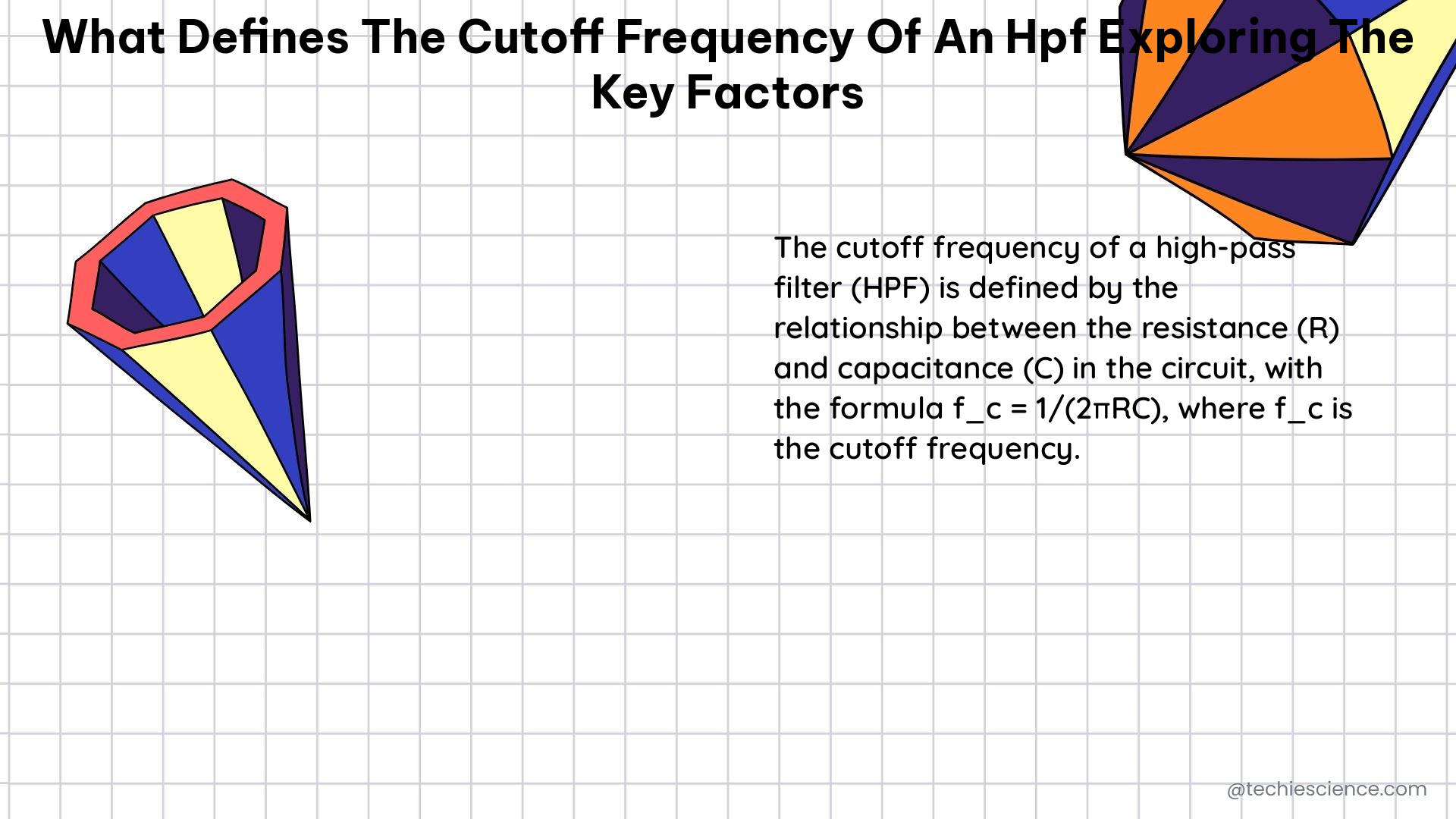The cutoff frequency of a high-pass filter (HPF) is a crucial parameter that defines the point at which the filter starts to take effect, serving as a boundary between the frequencies that are allowed to pass and the frequencies that are attenuated. It is a dynamic point of transition that shapes the audible and visual world around us, playing a significant role in various electrical engineering and signal processing applications, such as smartphones, radios, oscilloscopes, and signal generators.
Understanding the Cutoff Frequency Formula
The cutoff frequency (fc) of an HPF can be calculated using the formula:
fc = 1/4π√(LC)
Where:
– L is the inductance
– C is the capacitance of the filter
This formula is derived from the transfer function of a high-pass filter, which is given by the equation:
Vout(s)/Vin(s) = 1/(1-j/ωRC)
Where:
– ωc = 1/RC is the cutoff frequency in rad/s
– fc = ωc/2π is the cutoff frequency in Hz
Adjusting the Cutoff Frequency in Audio Processing

In the context of audio processing, adjusting the cutoff frequency often involves experimentation and fine-tuning to achieve the desired effect. For example, when working with a kick drum track, you might start with a relatively low cutoff frequency to remove unwanted low-frequency rumble while preserving the fundamental frequency of the kick. As you increase the cutoff frequency, you may find that the kick drum starts to lose its low-end impact. To rectify this, you can fine-tune the cutoff frequency to strike the perfect balance between eliminating unwanted lower frequencies and preserving the kick drum’s power and character.
Resonance and Its Impact on Cutoff Frequency
Resonance, usually displayed as “Q” in DAWs, occurs when a filter amplifies or emphasizes a specific frequency or frequency range, causing it to stand out and become more pronounced in the output signal. In high-pass filters, resonance can be applied by introducing a peak or boost near the cutoff frequency, which can be especially useful in sound design and synthesis, where adding resonance can emphasize specific harmonics or frequency bands, giving the filtered sound a distinct tonal quality.
Frequency Response and Phase Shift
The frequency response of a high-pass filter is a graphical representation of how the filter affects the amplitude of different frequency components in the input signal. It shows the relationship between the input and output signals’ amplitudes as a function of frequency, providing insight into the filter’s performance across the frequency spectrum. A typical frequency response plot for a high pass filter will show a gradual attenuation of low-frequency signals below the cutoff frequency, becoming more pronounced as the frequency decreases. Above the cutoff, the frequency response plot will show a relatively constant gain, indicating that high-frequency signals are allowed to pass through the filter with minimal attenuation.
Phase shift is another important characteristic of the high pass filter, which describes the change in phase (or timing) of the output signal compared to the input signal. It occurs due to the reactive nature of the passive components used in the high-pass filter circuit. In a high-pass filter, the phase shift increases as the cut off frequency changes and resonance is introduced, with the largest phase shift occurring near the cut off frequency point. This can result in subtle timing differences between the input and output voltage signals, which may affect the overall sound quality and perception of the audio.
Cutoff Frequency in Digital Signal Processing (DSP)
In the realm of digital signal processing (DSP), the concept of cutoff frequency is just as relevant and important as it is in analog systems. DSP involves the manipulation of signals that have been digitized, and these signals can also be filtered based on frequency. Digital filters, such as Finite Impulse Response (FIR) and Infinite Impulse Response (IIR) filters, also have a cutoff frequency that determines which frequencies are passed and which are stopped. The design and implementation of these filters involve mathematical algorithms run on digital processors. These digital filters are used extensively in various applications such as audio processing, image processing, and telecommunications.
Practical Considerations and Testing Equipment
Understanding and controlling the cutoff frequency is crucial for filtering out noise, focusing on desired frequency bands, and improving the functionality of electronic systems. Whether you’re an electronics enthusiast or an experienced engineer, mastering the concept of cutoff frequency requires not just theoretical understanding but also practical, hands-on experience. Having access to reliable and high-quality testing equipment is essential for this journey, and Keysight’s Used Equipment Store offers an expansive collection of top-notch, pre-owned testing equipment, guaranteeing the best used equipment with like-new condition, updated firmware, full calibration, new accessories, like-new warranty, and customization possibilities.
References:
– Why is the cutoff frequency of this highpass filter with formula different from the actual cutoff frequency?
– High-Pass Filters
– High-Pass Filter
– Cutoff Frequency
– The cut-off frequency for high-pass filter is

The lambdageeks.com Core SME Team is a group of experienced subject matter experts from diverse scientific and technical fields including Physics, Chemistry, Technology,Electronics & Electrical Engineering, Automotive, Mechanical Engineering. Our team collaborates to create high-quality, well-researched articles on a wide range of science and technology topics for the lambdageeks.com website.
All Our Senior SME are having more than 7 Years of experience in the respective fields . They are either Working Industry Professionals or assocaited With different Universities. Refer Our Authors Page to get to know About our Core SMEs.